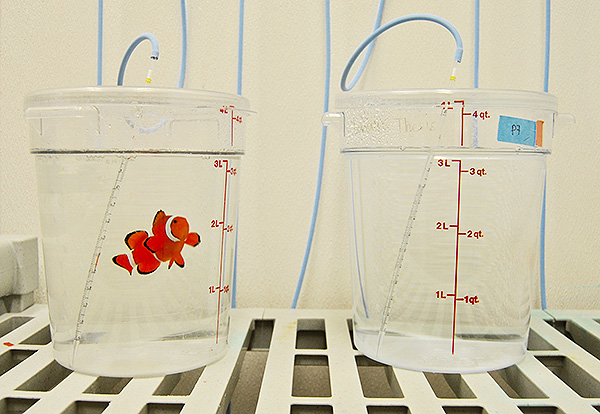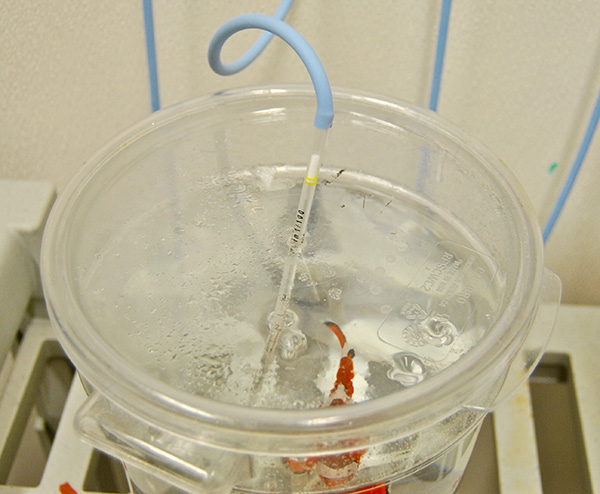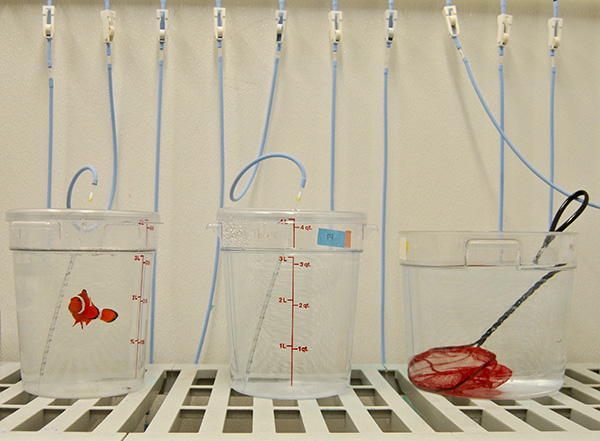
An economical quarantine method being used by the Roger Williams University Marine Lab calls for keeping incoming fish singly in 1-gallon or 1.5-gallon polycarbonate buckets and moving them daily into clean water.
Bucket Transfer Quarantine
A streamlined method from the Roger Williams University marine breeding lab
By Joseph Szczebak
Excerpt from Reefkeeping 101, CORAL Magazine, March/April 2017
Quarantine is an essential tool for every aquarist, whether hobbyist, public aquarist, or breeder. All incoming fishes, whether wild-caught or captive-bred, should undergo a minimum of two to four weeks of quarantine for observation, acclimation, and prophylactic treatment before being transferred to a permanent home.
Even if fishes come from a reputable source with known quarantine protocols, they are often stressed during bagging and transport, which makes them susceptible to disease and infection upon arrival. Many amateur aquarists skip quarantine, believing it is too expensive to set up a separate system that only gets intermittent use. By revolutionizing the quarantine process to make it more compact and efficient and less expensive, we hope to encourage more aquarists to undertake this necessary and beneficial husbandry practice.

Joe Szczebak, research associate at the Roger Williams University Marine Lab in Rhode Island, where he works with Dr. Andy Rhyne in developing protocols for breeding marine aquarium fishes.
While there are countless schools of thought on the ideal setup and technique for fish quarantine, the Marine Lab at Roger Williams University (RWU) is partial to a version of the “transfer method” coined in Dieter Untergasser’s 1992 Handbook of Fish Diseases. In this long-established method, the fish is acclimated to a quarantine tank and treated with medication. After a period of time (usually two or three days) it is transferred to a second quarantine tank with identical water chemistry. The original tank is then sanitized and prepared to be used two to three days later. The series of “transfers,” though labor intensive, can help combat even very resilient pathogens.
Many pathogens that chronically plague marine fishes, like Velvet (Amyloodinium ocellatum) and Marine Ich (Cryptocaryon irritans), have complex life cycles that involve both benthic cyst and free-swimming stages in addition to the active parasitic phase. By removing your fish from the quarantine tank, discarding the old water, and sanitizing the tank before reuse, you are effectively eliminating those more cryptic and resilient life stages, which drastically decreases the chances that the fish will become reinfected.
Despite what we see as the advantages, this method has met with mixed reviews. The technique is arguably more labor intensive than other quarantine methods, requiring frequent cleanings, transfers, and setups. It is often more expensive, too, as you need multiple quarantine setups through which to rotate fishes. From an animal health standpoint, the constant netting and transfer of fishes can increase their stress at a time when it is already high. Furthermore, great care is needed to ensure that all essential water parameters in each new quarantine tank (temperature, salinity, pH, etc.) match those of the previous tank.
The Roger Williams Marine Lab has challenged the reputation of the Tank Transfer Method by developing a rendition that is simple and scalable—and can be tucked away when not in use.

Aeration is provided via a pipette inserted into the cover of each bucket.
A SIMPLER APPROACH
All fishes arriving at the Marine Lab are quarantined individually for at least four weeks. While medication type, dose, and duration ultimately depend on the fish and the situation, fishes are normally treated for two weeks with praziquantel to kill worms, followed immediately by two weeks on copper, which works against numerous types of external parasites. Tank transfers occur daily, and fishes get a daily freshwater dip before each transfer for at least the first two weeks of the quarantine period.
MATERIALS
We have replaced the traditional rows of glass aquariums with clear round polycarbonate buckets with lids (Cambro brand). Depending on fish size, we use bucket sizes ranging from 4-quart to 22-quart that can be purchased from an online restaurant supply store (e.g., KaTom.com) or Amazon.com (see Sources, below). Polycarbonate buckets are durable and can be subjected to chlorine solutions or high heat, which is how we sanitize our supplies. Also, the round buckets prevent the injuries that can occur in containers with corners.
A disposable 1-ml rigid plastic pipette is inserted into a 1/4″ hole drilled into the bucket lid to supply air to the quarantine tank. The pipette is connected to 3/16″ silicone tubing, which is more flexible, heat-resistant, and long-lasting than vinyl and allows for fine airflow adjustment using plastic roll clamps (Pentair Aquatics, pentairaes.com). We purchase the pipettes from a lab supply company (see Sources) and the airline tubing from either Pentair Aquatics or Omega Engineering (omega.com).
An additional Cambro polycarbonate bucket with lid is used as a freshwater dip bucket. A fine-mesh fish net is used to transfer the fish.
PROCESS
On the first day of quarantine, the fish is acclimated to the water conditions being used for the quarantine period in a separate container. During this time, the quarantine bucket is filled with seawater, dosed with medication and allowed to aerate for several minutes. After acclimation is complete, the fish is netted into the quarantine bucket and the bucket is lidded. Another polycarbonate bucket is then filled with RODI water buffered to the pH of the quarantine bucket. This bath sits overnight to ensure it is the same temperature as the water in the quarantine bucket.
The following day, a second sanitized quarantine bucket is set up, filled with seawater matching the water quality of the first bucket, dosed with medication, and allowed to aerate for several minutes. Then the fish is gently netted from the quarantine bucket and placed in the freshwater dip bucket that was prepared the night before. The duration of the freshwater dip depends on the species; we aim for at least two minutes per day. After the bath is complete, the fish is netted into the newly prepared quarantine bucket and the bucket is lidded.
All contents from the original quarantine bucket, including the lid, the rigid plastic pipette, and all components of the freshwater dip, are sanitized. Our lab uses a commercial pasteurizer to make 185˚F (85˚C) water. All items are submerged in this hot water bath for at least 30 seconds and stored for the next use. Finally, the sanitized freshwater dip bucket is refilled, buffered, and allowed to sit overnight. A hobbyist can use scaled-down methods, as described below.
The procedures described for the second day are repeated each day for the duration of the quarantine period. During this time, medications, diets, and dips can be adjusted as needed. Once the quarantine period is complete, we typically give the fish one final freshwater dip after it has been acclimated (drip method) to its permanent tank, immediately before it is added.
Using this method, we recently completed a four-week quarantine period for 20 new broodstock fishes. One person was able to complete the daily transfer process for all 20 fishes in two hours per day while freshwater dips were being employed (20 fishes at three minutes per fish = one hour of dips!), and one hour per day when freshwater dips were no longer needed. If only several fishes are being quarantined at a given time, this entire process can be completed in less than 20 minutes a day. Daily labor can be further decreased by having more than one extra bucket, so sanitation can be completed less frequently.

Rotating buckets allow improved quarantine success by stopping pest proliferation. Bucket on right is used for daily fresh water dips when fishes are being moved.
The procedures described for the second day are repeated each day for the duration of the quarantine period. During this time, medications, diets, and dips can be adjusted as needed.
Once the quarantine period is complete, we typically give the fish one final freshwater dip after it has been acclimated (drip method) to its permanent tank, immediately before it is added.
Using the above method, we recently completed a four-week quarantine period for 20 new broodstock fishes. One person was able to complete the daily transfer process for all 20 fishes in two hours per day while freshwater dips were being employed (20 fishes at three minutes per fish = one hour of dips!), and one hour per day when freshwater dips were no longer needed. If only several fishes are being quarantined at a given time, this entire process can be completed in less than 20 minutes a day. Furthermore, if numerous fishes can be done in batches, the total transfer time can be reduced greatly.
TIPS
As an alternative to pasteurization (which is unrealistic for most), all equipment can be sanitized in a dishwasher (use the “high heat” or “sanitize” setting without soap) or an overnight chlorine bleach bath.
We keep a 42-gallon (160-L) reservoir of standing seawater available throughout the quarantine period. The reservoir is maintained at the same temperature as the quarantine setups. At the end of each day we top it off and adjust the salinity if needed. Ideally, we set up the quarantine buckets in an area where the ambient temperature is fitting for the fish being held, but if this is not possible, a simple water bath could be used. The water bath should be large enough to hold the current quarantine bucket as well as the bucket “on deck,” so that it can sit overnight for temperature stabilization.
While in quarantine, fishes are fed twice per day. The first feeding occurs in the morning before the transfer process. This is usually a heavier feed, as any uneaten food will be discarded during the transfer. The fishes are offered a second (lighter) feeding in the evening. We use a live feed, such as baby brine shrimps or copepods, in the evening so that any uneaten food will not decay overnight. Based on our experience, brine shrimps and copepods can withstand the recommended doses for both praziquantel and copper overnight without succumbing.
About the RWU Marine Lab:
Roger Williams University is a student-centric liberal arts university in oceanfront Rhode Island. The RWU Center for Economic & Environmental Development (CEED) operates over 7,000 square feet (650 square meters) of marine laboratories, including one dedicated to the aquaculture of marine ornamentals, which is run by Dr. Andrew Rhyne. CEED offers undergraduate students the unique opportunity to conduct hands-on applied research in all aspects of aquaculture, including extensive studies on the culture of marine ornamental species, with an emphasis on the key bottlenecks that inhibit commercial ornamental production and sustainable aquarium trade expansion. Brad Bourque manages the lab facilities and Joe Szczebak is a research associate.
REFERENCE
Unterwasser, G. and D. Unterwasser. 1992. Handbook of Fish Diseases. TFL Publications, Neptune City, NJ.
FURTHER INFORMATION
Roger Williams University, Center for Economic & Environmental Development: http://rwu.edu/academics/schools-colleges/fcas/ceed
SUPPLIES SOURCES
BUCKETS
Cambro 4-qt (1-gal) Camwear Round Storage Container – Clear
https://www.katom.com/144-RFSCW4135.html
Cambro 6-qt (1.5-gal) Camwear Round Storage Container – Clear
https://www.katom.com/144-RFSCW6135.html
PIPETTES
Serological Pipets
TUBING & VALVES
Silicone Tubing
Hagen Marina Blue Airline Tubing available at many local aquarium retailers
https://ca-en.hagen.com/Aquatic/Aeration/Accessories/A1123
Valves





Do you have any evidence this is any better than other methods? I assume you tried and compared to other methods before settling on this. Did you compare copper to Chloroquine phosphate? – I ask as this is what I’ve been using in my QT (also alternate dips in Sera Tremazol and myzaxin).
Are you using this protocol for large fish? What type of container do you use for tangs? Id think something like an Achilles tang would have undue stress being in such a small container.
What about using this method for oscar tank mates?